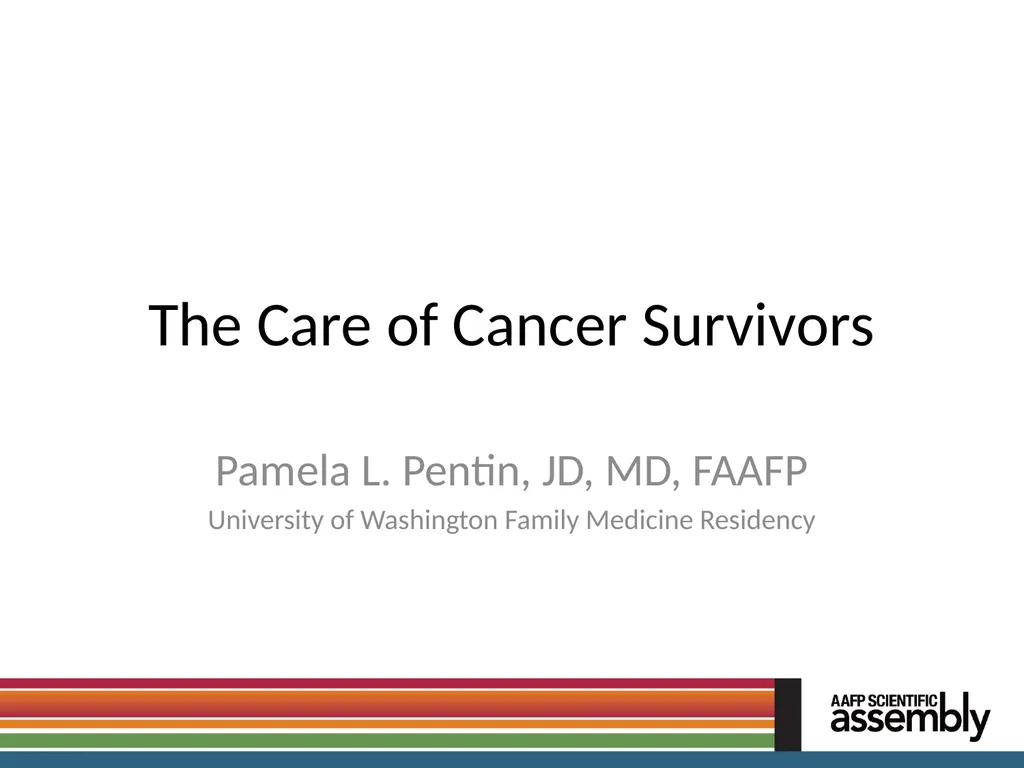The Care of Cancer Survivors Pamela L. Pentin, JD,
Author : conchita-marotz | Published Date : 2025-05-22
Description: The Care of Cancer Survivors Pamela L Pentin JD MD FAAFP University of Washington Family Medicine Residency General Principles Surveillance for recurrence of primary cancer Screening for development of a second primary malignancy
Presentation Embed Code
Download Presentation
Download
Presentation The PPT/PDF document
"The Care of Cancer Survivors Pamela L. Pentin, JD," is the property of its rightful owner.
Permission is granted to download and print the materials on this website for personal, non-commercial use only,
and to display it on your personal computer provided you do not modify the materials and that you retain all
copyright notices contained in the materials. By downloading content from our website, you accept the terms of
this agreement.
Transcript:The Care of Cancer Survivors Pamela L. Pentin, JD,:
The Care of Cancer Survivors Pamela L. Pentin, JD, MD, FAAFP University of Washington Family Medicine Residency General Principles Surveillance for recurrence of primary cancer Screening for development of a second primary malignancy Long-term physical effects of treatment Psychosocial consequences of treatment AND fear of recurrence Maintain wellness “Joe” 59 yo man without health insurance for 30 years Hx “thymus cancer” as infant Several weeks of radiation therapy No old medical records No surveillance Only complaint -> chronic weak voice Individualized Survivorship Plan Bio …. …. Psycho …. …. Social Integrated with cancer care providers In many cases, by primary care alone Resources American Society of Clinical Oncology National Comprehensive Cancer Network American Cancer Society Children’s Oncology Group “Survivorship Guidelines” American Society of Clinical Oncology Clinical guidelines for surveillance On-line Flow Sheets Surveillance by primary care is ENCOURAGED (exceptions are spelled out) “Patients who desire follow-up exclusively by a PCP may be transferred approximately ___ (time) post-diagnosis” http://www.asco.org National Comprehensive Cancer Network Alliance of 23 leading cancer centers Clinical guidelines for each types of cancer Each has “Surveillance” section Patient guidelines http://www.nccn.org American Cancer Society ASCO Cancer Treatment Summaries What’s Next? Life After Cancer Treatment Journey Forward – Survivorship Care Plan Builder Lance Armstrong Foundation LIVESTRONG SurvivorCare Program http://www.cancer.org/treatment/survivorshipduringandaftertreatment/index Children’s Oncology Group Long-Term Follow-Up Guidelines for Survivors of Childhood, Adolescent, and Young Adult Cancers Recommendations for screening/management late treatment effects Step by step web-based “Summary of Cancer Treatment” –> generates Patient Specific Guideline Will need old records for type and doses chemo/XRT http://www.survivorshipguidelines.org/ BREAST CANCER SURVIVORS Breast Cancer Survivors 2.1 million Americans Female: Male = 100:1 Increased risk second primary cancer – both breasts, ovaries and colorectal Most recurrences within 5 years following treatment – but threat persists 20+ years NCCN Post-Treatment Breast Cancer Surveillance Guideline Interval history and physical exam every 6 months for 5 years, then every 12 months Annual mammography of preserved tissue More intensive surveillance (labs, bone scans, CXR, tumor markers) does not improve survival or quality of life and may detract from symptoms-free periods – patients may need counseling about this NCCN Post-Treatment Breast Cancer Surveillance Guideline Women on Tamoxifen: annual gynecologic assessment every 12 months if uterus present Women on an aromatase inhibitor or who experience ovarian failure secondary to treatment should have monitoring of bone health with a bone mineral density determination at baseline and periodically thereafter Assess and encourage adherence to adjuvant














